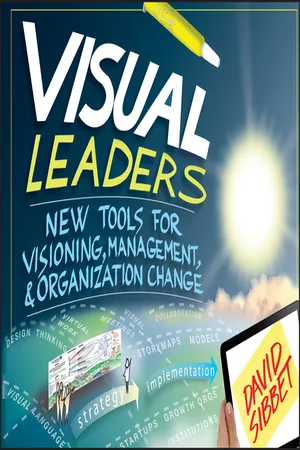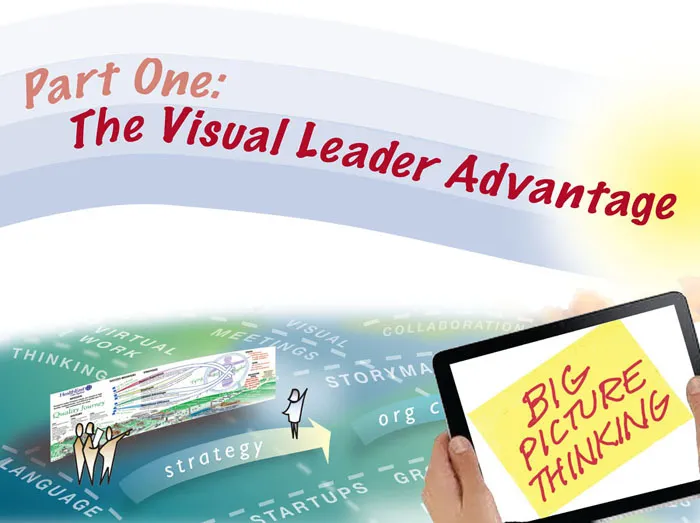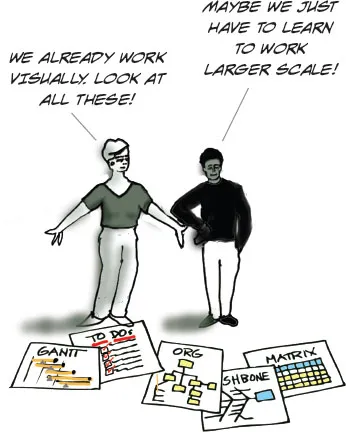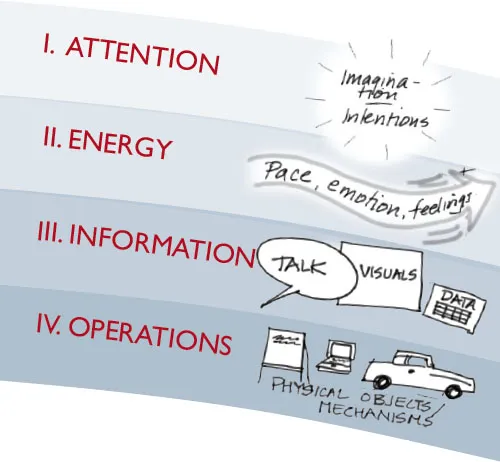![]()
Part One: The Visual Leader Advantage
1: Seven Essential Tools This book begins by reviewing the most essential tools for visualization that a leader should have in his or her toolkit. Part Three will elaborate on these. This overview covers the use of metaphor and models, graphic facilitation, graphic templates, decision theaters, roadmaps, storymaps, video, and what you can do with virtual visualization.
2: Seeing Results in Action This chapter tells the story of visual leaders in a health-care organization who learned to use many of the essential tools indicated in this part. They were not skilled at drawing or experienced at visualization but got terrific results and moved to make visualization a standard way of working in their organization. The case is interleaved with practices you can use right away.
3: How to Run Visual Meetings This chapter covers what every manager should know about how to work with visual meetings and visual practitioners. Leaders set the norms for how everyone relates in meetings. There is creative room for shaping expectations and opportunities if you have a clear idea of what results you would like to achieve.
![]()
1. Seven Essential Tools
Metaphors & Models, Visual Meetings, Graphic Templates, Decision Rooms, Roadmaps, Storymaps, & Video
Have you ever set out to learn something new as an adult, say playing a sport or a musical instrument? You probably already know something about whatever you set out to learn, or you wouldn’t be attracted to it, but chances are, you didn’t learn the underlying discipline or practice enough to be masterful. If you are lucky, you will find a teacher who has experience and knows how to pick just the right foundation elements upon which you can build more proficiency. It’s a step-at-a-time process.
If you are young and immersed in visual media already, you’ll benefit from seeing what an experienced person like myself has found that works across a broad range of organizations and leaders. You can check to make sure your foundation skills are strong.
If you are more experienced, perhaps having learned to read your own form of “sheet music” for leadership, you can look forward to broadening your repertoire by learning some of the underlying theory and practices that will allow you to improvise in different situations and different organizations.
Beginning with the Tried-and-True
In music, beginning simply and building step by step with the basic elements that every musician knows makes all the difference. The goal, if you are studying jazz, is to have freedom of improvisation. But interestingly, a good teacher will start with the constraint of learning basic melodies, keys, and chords rather than sheet music with all the notes. Sheet music doesn’t really teach you what the music is about, or encourage a wide range of possible variations. If you put basics first, in a short time your playing will jump to a whole new level. Visualization tools function just like the basic components of music. As with music you’ll learn specific melodies (strategies and practices) that sound great even in their more basic states. This is the approach we’ll take in regard to visual leadership. All the way along are stories that explain the “music” and exercises that will teach you the basics. If you practice them as suggested in this book, you’ll literally see the results. Because this book is written for leaders and managers, I’ve included the basics on improving your visual IQ, as well as coaching and guiding your teams to work visually so they don’t necessarily rely on you to do it all. This chapter is for orientation, and then each tool will get its own chapter in Part Three. As you begin to get the basic ideas, we will improvise around the edges and you’ll hopefully get a sense of the larger world of visualization that awaits. It’s every bit as vast as music!
What Is a Visual Tool?
“Tool” is clearly a metaphor. It’s used to indicate tangible things you can do to get desired results. Every tool is a product of some intention to do something. With repeated use, a tool will evolve and become refined. A good tool will have a central use but will also be usable for things other than it was intended. For instance, a good hammer could be used to prop open a door. In this book the metaphor of tool indicates any distinct, learnable process or practice that can be described and repeated to get an effect, such as the Four Flows framework on this page.
When thinking through all the tools a visual leader can use, it helps to understand the repeating challenges that a leader needs to meet, in any situation, at the broadest level. From the widest possible point of view, your challenge is to focus organizational awareness, support engagement of your people, clarify insights into the right things to be doing, and build ownership in projects and initiatives. A simple Goals of Leadership model is illustrated on the next page (an improvisation on Four Flows). The seven essential tools are ones you can use to meet these goals.
Appreciate that any generalization like this is for the sake of revealing the foundational elements, not all the variations, just as in the music. As you read this chapter let your own experience resonate with the examples and work out your own adaptation of this framework.
FOUR FLOWS THINKING
The Four Flows framework is a key tool for facilitators, but it also relates to leadership. You may have noticed the band of four shades of blue that run across the opening Parts pages of this and previous books. It is a graphic way of indicating the four ways humans make sense of things. In common terms we talk about spirit, soul, mind, and body. Carl Jung identified these as intuiting, feeling, thinking, and sensing modes of knowing. Here we call them attention, energy, information, and operations. All tools in leadership and management are aimed at handling these singly or in combination.
Cartoonists use 0-dimensional, 1-dimensional, 2-dimensional and 3-dimensional graphics to show the same idea.
Goals of Leadership
Ed Friedrichs, former chief executive officer of Gensler, a very successful, large architecture firm, says, “Leaders focus on doing the right things and managers focus on doing things right. You need both in an organization, even though people often have leanings one way or the other.” This book is written for both, so keep both in mind as you look at the five goals illustrated on this page. At the most general level, leaders and managers focus on what needs to be done, with whom, in what time frames, and with what kind of quality.
It all adds up to fostering as much understanding of all the right things to be doing distributed as widely as possible throughout your organization. In living systems the DNA instructions are in every cell!
AN ASIDE ON MNEMONICS
Memory experts have long understood that visualization is a key to the kind of memory stunts stage magicians demonstrate. A former White House chief of staff would, in the morning, imagine his day and all its issues and events as dishes on top of a stove in a kitchen. He would imagine which were on the front burners, which in the back, and which were on the side being prepared, laying out the whole day that way. The image helped him remember everything. Visual models such as the one below, with memorable acronyms, are ways to remember important information without having to have notes. Don’t confuse them with the real world itself. Use them like lenses, looking through them to see both what fits and what doesn’t in your actual situation.
What Does It Mean to “Understand”?
You might recognize in the DNA analogy on the previous page a bias toward thinking of organizations as living systems (as distinguished from mechanical systems). In living systems the DNA contains the story of how different parts of the organism should grow and behave. If a cell in a plant finds itself underground, it knows to be a root. If it finds itself at the end of a branch, it becomes a leaf. There is no “central command” in a plant.
The lesson from this analogy is that when people truly know how their work relates to bigger goals and have a fully developed understanding of the way in which they...




